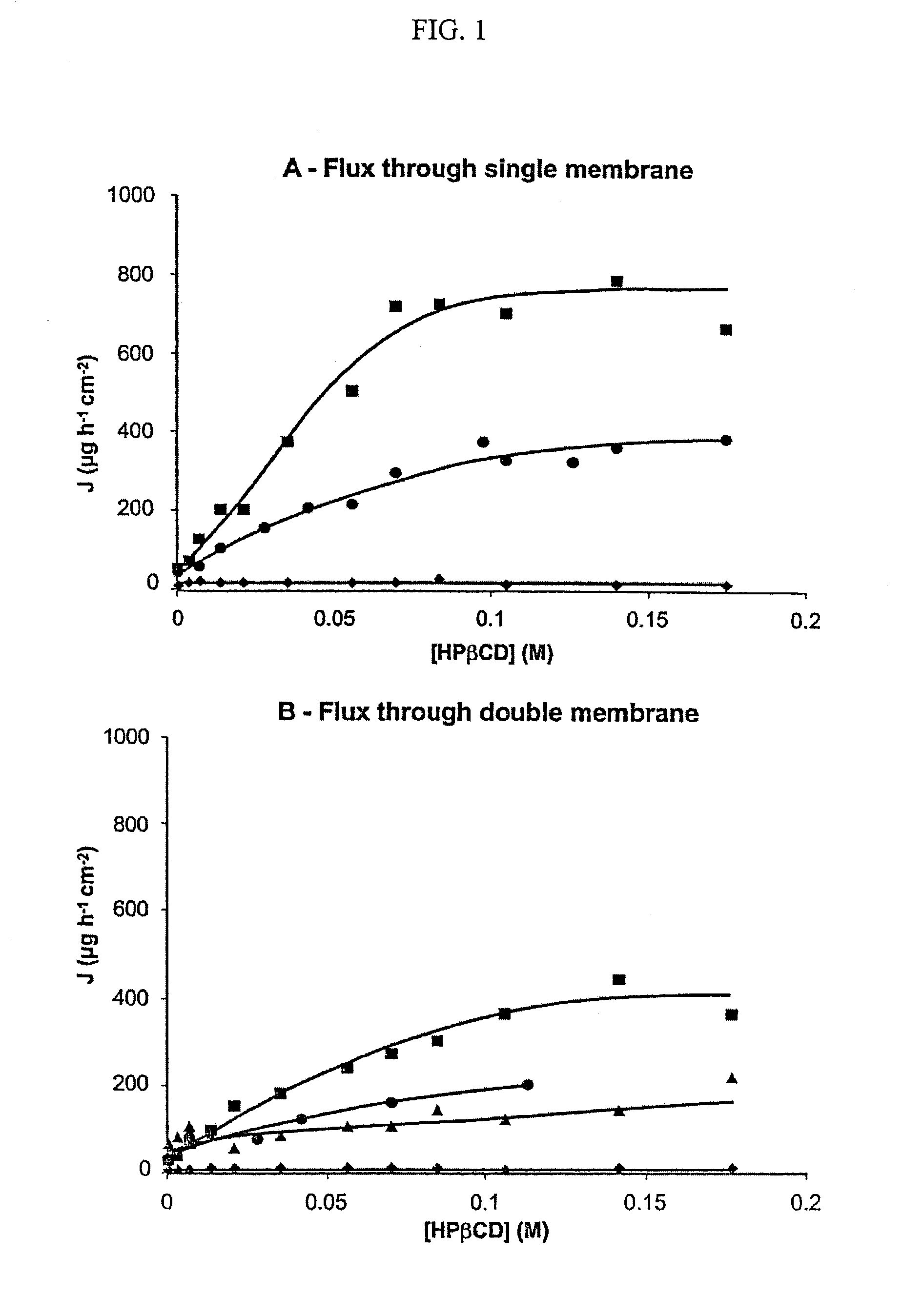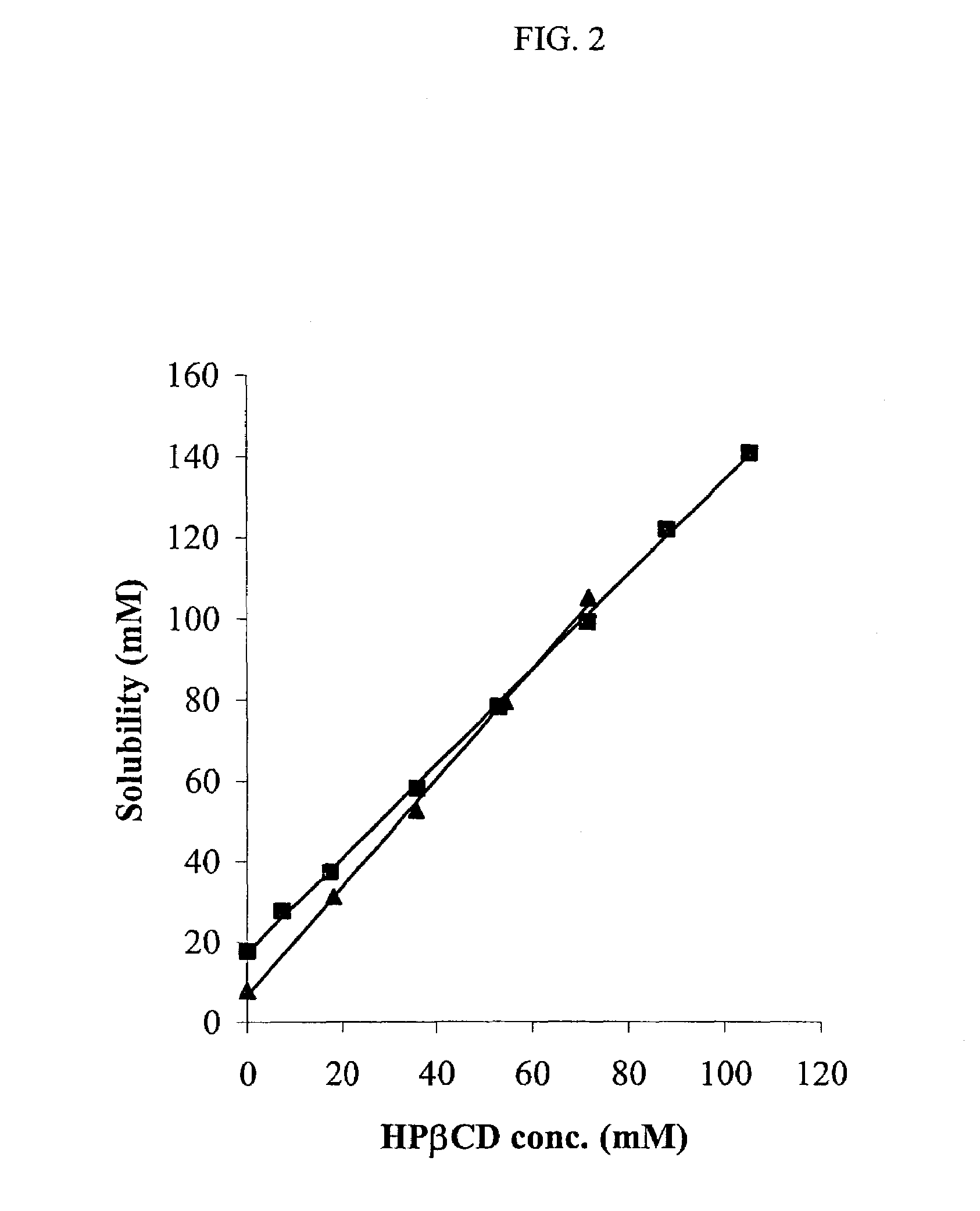Non-inclusion cyclodextrin complexes
a technology of cyclodextrin and complexes, which is applied in the field of non-inclusion cyclodextrin complex microaggregates, can solve the problems of increasing the aqueous solubility of cyclodextrins, the complexation efficiency of cyclodextrins is often rather low, and the pharmaceutical application of cyclodextrins is its complexation efficiency. achieve the effect of enhancing the aqueous so
- Summary
- Abstract
- Description
- Claims
- Application Information
AI Technical Summary
Benefits of technology
Problems solved by technology
Method used
Image
Examples
experiment b
[0105]The solubility of hydrocortisone was determined in aqueous unbuffered solution containing either pure water or 4% (w / v) βCD in a suspension, with and without presence of 0.25% (w / v) hydroxypropyl methylcellulose 4000 (HPMC), and sodium salicylate concentrations from 0 to 312 mM. An excess amount of hydrocortisone was added to the aqueous solutions or βCD suspension, and the hydrocortisone suspension formed was heated in a sealed vial in an autoclave (121° C. for 20 minutes). After equilibration at room temperature (22–23° C.) overnight, the vials were opened, a small amount of solid hydrocortisone was added to each vial and the aqueous suspensions were allowed to equilibrate at room temperature under constant agitation for additional 6 days. The pH of the unbuffered solutions was about 7.4. After equilibration, the suspensions were filtered through 0.45 μm nylon membrane filters and the filtrate was analyzed by HPLC.
[0106]
TABLE 2Solubility of hydrocortisone (mM)SalicylatePure ...
experiment c
[0109]The solubility of hydrocortisone was determined in aqueous unbuffered 0 to 8% (w / v) βCD solutions or suspensions containing either no or 1% (w / v) sodium acetate, with and without the presence of 0.25% (w / v) hydroxypropyl methylcellulose 4000 (HPMC). An excess amount of hydrocortisone was added to the aqueous solutions or βCD suspension, and the hydrocortisone suspension formed was heated in a sealed vial in an autoclave (121° C. for 20 minutes). After equilibration at room temperature (22–23° C.) overnight, the vials were opened, a small amount of solid hydrocortisone was added to each vial and the aqueous suspensions were allowed to equilibrate at room temperature under constant agitation for an additional 6 days. The pH of the unbuffered solutions was about 6.9. After equilibration, the suspensions were filtered through 0.45 μm nylon membrane filters and the filtrate was analyzed by HPLC. The results are shown in FIG. 8.
[0110]Both βCD and the hydrocortisone / βCD complex have ...
experiment d
[0112]The solubility of hydrocortisone was determined in aqueous unbuffered 0 or 1% (w / v) βCD solutions or suspensions containing either no or 1% (w / v) benzalkonium chloride, with and without the presence of 0.25% (w / v) hydroxypropyl methylcellulose 4000 (HPMC). An excess amount of hydrocortisone was added to the aqueous solutions or βCD suspension, and the hydrocortisone suspension formed was heated in sealed vial in an autoclave (121° C. for 20 minutes). After equilibration at room temperature (22–23° C.) overnight, the vials were opened, a small amount of solid hydrocortisone was added to each vial and the aqueous suspensions were allowed to equilibrate at room temperature under constant agitation for an additional 6 days. After equilibration, the suspensions were filtered through 0.45 μm nylon membrane filters and the filtrate was analyzed by HPLC. The results are shown in Table 4. The table shows that when no polymer is present, adding 1% (w / v) benzalkonium chloride to aqueous ...
PUM
| Property | Measurement | Unit |
|---|---|---|
| temperature | aaaaa | aaaaa |
| solubility | aaaaa | aaaaa |
| solubility | aaaaa | aaaaa |
Abstract
Description
Claims
Application Information
 Login to View More
Login to View More - R&D
- Intellectual Property
- Life Sciences
- Materials
- Tech Scout
- Unparalleled Data Quality
- Higher Quality Content
- 60% Fewer Hallucinations
Browse by: Latest US Patents, China's latest patents, Technical Efficacy Thesaurus, Application Domain, Technology Topic, Popular Technical Reports.
© 2025 PatSnap. All rights reserved.Legal|Privacy policy|Modern Slavery Act Transparency Statement|Sitemap|About US| Contact US: help@patsnap.com



